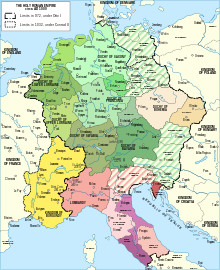|
部族大公 部族大公(ぶぞくたいこう、英:Stem duke、独:Stammesherzog)とは、10世紀、カロリング朝の断絶および帝国の再興時に中世ドイツに成立した大公。 概要「部族」とはゲルマンの部族であるフランク、サクソン、バイエルン、アラマンニ(シュヴァーベン)を指す。 カロリング朝は8世紀に旧来の部族大公領を解体させていたが、9世紀末のカロリング朝の没落とともに、旧来の部族領が王国の分領地と認識されるようになった。この時成立した部族大公領は、フランケン大公領、ザクセン大公領、バイエルン大公領、シュヴァーベン大公領(アレマニア大公領)およびロートリンゲン大公領の5つであった[1]。 部族大公領はザーリアー朝統治下のドイツにおいても主要な分領地でありつづけたが、中世盛期初期のホーエンシュタウフェン朝下では次第に廃れていき、最終的に1180年にフリードリヒ1世がより多くの公領を設置し廃止された。 ドイツ語の部族大公領「Stammesherzogtum」という言葉は、19世紀半ばにゲルマン史学の中で用いられるようになったが、それはドイツ統一の問題と関連があった。それゆえこの語の適用性および中世ドイツにおける部族大公の実態については長い間議論の対象となっている。その英語の直訳である「stem duchy」は20世紀初期に用いられるようになった新造語である[2]。その後、「tribal」の語が用いられる傾向はあるものの、「stem duchy」の語が一般的となっている[3]。
脚注
関連項目 |
Index:
pl ar de en es fr it arz nl ja pt ceb sv uk vi war zh ru af ast az bg zh-min-nan bn be ca cs cy da et el eo eu fa gl ko hi hr id he ka la lv lt hu mk ms min no nn ce uz kk ro simple sk sl sr sh fi ta tt th tg azb tr ur zh-yue hy my ace als am an hyw ban bjn map-bms ba be-tarask bcl bpy bar bs br cv nv eml hif fo fy ga gd gu hak ha hsb io ig ilo ia ie os is jv kn ht ku ckb ky mrj lb lij li lmo mai mg ml zh-classical mr xmf mzn cdo mn nap new ne frr oc mhr or as pa pnb ps pms nds crh qu sa sah sco sq scn si sd szl su sw tl shn te bug vec vo wa wuu yi yo diq bat-smg zu lad kbd ang smn ab roa-rup frp arc gn av ay bh bi bo bxr cbk-zam co za dag ary se pdc dv dsb myv ext fur gv gag inh ki glk gan guw xal haw rw kbp pam csb kw km kv koi kg gom ks gcr lo lbe ltg lez nia ln jbo lg mt mi tw mwl mdf mnw nqo fj nah na nds-nl nrm nov om pi pag pap pfl pcd krc kaa ksh rm rue sm sat sc trv stq nso sn cu so srn kab roa-tara tet tpi to chr tum tk tyv udm ug vep fiu-vro vls wo xh zea ty ak bm ch ny ee ff got iu ik kl mad cr pih ami pwn pnt dz rmy rn sg st tn ss ti din chy ts kcg ve
Portal di Ensiklopedia Dunia